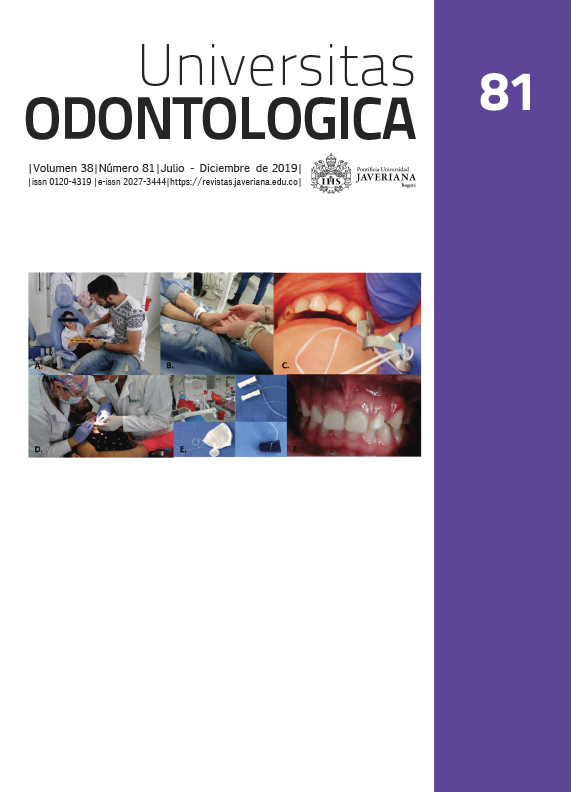Abstract
Background: Psychoeducation improves the adaptations of people with autism to new environments or activities through learning processes. Case description: Interdisciplinary intervention to develop skills and abilities in the patient with autism TEA (Autism Spectrum Disorder) in the dental practice. 19-year-old male patient with diagnosis Generalized developmental disorder (TGD), typical autism. The intraoral clinical examination presents generalized calcified bacterial plaque and initial lesions of active caries. The proposed interventions are intended to improve patient behavior and anxiety, enhance tolerance in the dental practice of the patient before oral procedures and improve oral health conditions in the patient. The treatment included anticipation strategies, routines, extinction, setting of the space in which, specific protection, periodontics and basic operating procedures are programmed. Conclusions: The model proposed in this document to facilitate the dental care of people with ASD proposes various strategies within the currents in psychology and special education. Sessions with the support of psychoeducational strategies culminate with positive results for the patient's oral health and a progressive improvement in the patient's behavior.
2. Van Naarden Braun K, Christensen D, Doernberg N, Schieve L, Rice C, Wiggins L, Schendel D, Yeargin-Allsopp M. Tendencias en la prevalencia del trastorno del espectro autista, parálisis cerebral, pérdida de audición, discapacidad intelectual y discapacidad visual. Atlanta metropolitana, 1991-2010. Más uno. 2015; 10 (4).
3. Lyall K, Schmidt RJ, Hertz-Picciotto I. Maternal lifestyle and environmental risk factors for autism spectrum disorders. Int J Epidemiol 2014; 43(2): 443-64
4. Lorenz K. King Solomon’s ring: new light on animal ways. Routledge, London. 2002.
5. Hervás A. "Un autismo, varios autismos. Variabilidad fenotípica en los trastornos del espectro autista [XVIII Curso Internacional de Actualización en Neuropediatría y Neuropsicología Infantil]." Revista de Neurología. 2016; 2(1): 9-S14
6. Durand VM, Carr EG. Social influences on “self-stimulatory” behavior: analysis and treatment application. J Appl Behav Anal. 1987 Summer; 20(2): 119-32
7. Nazeer A, Ghaziuddin M. Autism spectrum disorders: clinical features and diagnosis. Pediatr Clin North Am. 2012; 59(1): 19-25
8. Association International Autisme Europe (AIAE) (2000). Description de l Áutisme, document prepare sous les auspicies do “Conseil dÁdministration dÁutisme Europe”. Bruselas: AIAE.
9. López Gómez, Santiago, and Consuelo García Álvarez. "Patrones comportamentales en el trastorno autista: descripción e intervención psicoeducativa." Educational Psychology. 2007; 13(2): 117-31.
10. Bostow, D and Bailey, J. Modification of severe disruptive and aggressive behavior using brief timeout and reinforcement procedures. Journal of Applied Behavior Analysis ABA. 1969; 2(1): 31-37.
11. Callahan K, Shukla-Mehta S, Magee S, Wie M. ABA versus TEACCH: the case for defining and validating comprehensive treatment models in autism. J Autism Dev Disord. 2010; 40(1): 74-88
12. Zink AG. Novo método de paciente autista. Rev APCD. 2011; 32: 10-11.
13. Gutiérrez, Laura; Ramírez, Jennifer. Estrategias pedagógicas aplicadas en el proceso de aprendizaje de personas con discapacidad cognitiva. Revista umbral científico. 2012; 21(9): p20-28.
14. Sanz López, Yolanda, Teresa Guijarro Granados, and Vicente Sánchez Vázquez. "Inventario de Desarrollo Battelle como instrumento de ayuda diagnóstica en el autismo." Revista de la asociación española de neuropsiquiatría. 2007; 27(2): 31-45.
15. Pitts, NB, KR Ekstrand y la Fundación ICDAS. "El Sistema Internacional de Detección y Evaluación de Caries (ICDAS) y su Sistema Internacional de Clasificación y Manejo de Caries (ICCMS, por sus siglas en inglés): métodos para organizar el proceso de caries y permitir que los dentistas manejen la caries". Odontología comunitaria y epidemiología oral. 2013; 41(1): e41-e52.
16. Orellana, Mirtala. Intervencion Psicoeducativa para facilitar el examen clínico odontológico de personas con TEA. Tesis Doctoral. Universidad de Valencia. Facultad de medicina. Departamento de estomatología. 2013.
17. Alaniz Paredes Astrid, Alvear-Córdova María Cristina, Paredes Andrés. Tratamiento estomatológico multidisciplinario de un paciente con trastorno de espectro autista: reporte de un caso. Revista OACTIVA UC Cuenca. Enero-Abril, 2017; 2(1): 43-50.
18. Oliva, Jacqueline. La comunicación en la atención estomatológica en niños autistas. Comunicación Social: retos y perspectivas. Centro de Lingüística Aplicada, Santiago de Cuba. 2015
19. Betancourt, Carlos Raúl. Atención diagnóstica y tratamiento odontológico primario del paciente autista en la consulta odontopediátrica. Trabajo de grado. Universidad de Guayaquil. Facultad Piloto de odontología. 2013
20. Rouches, A., et al. "Amélioration de la santé orale des enfants avec autisme: les outils à notre disposition." Archives de Pédiatrie. 2018; 25(2): 145-49.
21. Virues-Ortega, Javier, Flávia M. Julio y Roberto Pastor-Barriuso. "El programa TEACCH para niños y adultos con autismo: un metaanálisis de los estudios de intervención". Revisión de psicología clínica. 2013; 33(8): 940-53.
This journal is registered under a Creative Commons Attribution 4.0 International Public License. Thus, this work may be reproduced, distributed, and publicly shared in digital format, as long as the names of the authors and Pontificia Universidad Javeriana are acknowledged. Others are allowed to quote, adapt, transform, auto-archive, republish, and create based on this material, for any purpose (even commercial ones), provided the authorship is duly acknowledged, a link to the original work is provided, and it is specified if changes have been made. Pontificia Universidad Javeriana does not hold the rights of published works and the authors are solely responsible for the contents of their works; they keep the moral, intellectual, privacy, and publicity rights.
Approving the intervention of the work (review, copy-editing, translation, layout) and the following outreach, are granted through an use license and not through an assignment of rights. This means the journal and Pontificia Universidad Javeriana cannot be held responsible for any ethical malpractice by the authors. As a consequence of the protection granted by the use license, the journal is not required to publish recantations or modify information already published, unless the errata stems from the editorial management process. Publishing contents in this journal does not generate royalties for contributors.



